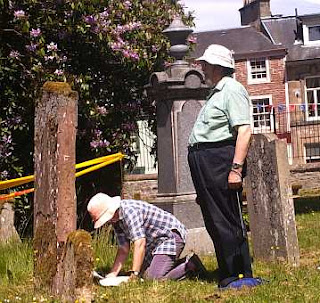Monday, June 21, 2010
Recording Gravestone Inscriptions at Jedburgh Abbey
This last weekend, 19th and 20th June, a group of volunteers from the Society were recording the gravestone inscriptions at Jedburgh Abbey, Roxburghshire.
In 1118, the Earl of Huntingdon, later king David I of Scotland, with the help of the Bishop of Glasgow founded a priory for Augustinian monks from Beauvais in northern France and elevated it in 1152 to the status of an abbey. The abbey is a superb example of Romanesque architecture in Scotland, and is thought to have taken about 120 years to build. The abbey and Jedburgh were frequently damaged in wars and skirmishes with the English. In 1416, 1464, and 1523, the town and abbey were damaged and / or burnt by the English, and it was burned in 1523 and ruined again in 1544, and in 1548, French troops occupied the town. The abbey was suppressed in 1559 and eventually purchased in 1637 by the third Earl of Lothian. A new parish church was built into the west part of the nave of the abbey from about 1671 and used until 1875 when a new parish church was erected a short distance away.
We've had groups recording gravestones before at Minto, near Denholm, Roxburghshire and at Duns, Berwickshire, and earlier this year, Stobo, Peeblesshire. We see these days as both an enjoyable day out for members and family, and as a training event for volunteers new to recording gravestones.
In spite of some "call offs", there were 13 of us working from 10am to 3.30 pm on Saturday, and 8 on Sunday from 1pm to 4.00 pm.
Including the gravestones in the abbey, there are about 400 gravestones in total. Saturday morning was unusually cold and windy for a June day, but the afternoon was much warmer. Sunday was a lovely warm sunny day, which proved slightly difficult for those trying to read faded inscriptions.
Checking inscriptions on the gravestones that Norma and I tackled on Sunday was hard work, and we managed only about 12 stones in about two and a half hours. There's still a lot of work to be done, but at least we've made a start.
The picture shows Morag and Ian Carter hard at work on one of the gravestones.
Our thanks to Historic Scotland for providing free entry for us to do the work.
To comment on this article, please click the 'comments' link below.
Subscribe to:
Post Comments (Atom)




1 comment:
Thank you for your efforts. I look forward to the time when you can share the fruits of your labour with we folk downunder.
Post a Comment
Comments ?